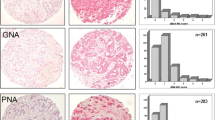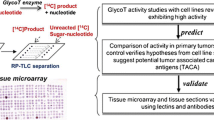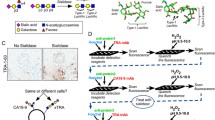Summary
Aberrant carbohydrate expression frequently occurs in breast cancer and may endow cells with metastatic potential. Here we first studied the relationship between expression of Vicia villosa agglutinin (lectin) (VVA)-binding carbohydrates and aggressive breast cancer. We then investigated the molecular characteristics of these glycoproteins and compared them with those of glycoproteins recognized by the mouse anti-Tn monoclonal antibody (MAb) HB-Tn1. Histochemical studies of samples from 322 cases of invasive ductal carcinoma demonstrated that VVA-binding carbohydrate expression correlated with tumor stage, lymphatic invasion, and lymph node metastasis (p=0.0385, p=0.0019, and p=0.0430. respectively). Western blotting analysis of frozen materials from 39 cases, under denaturing and reducing conditions, revealed that the major cancer cell-specific VVA-binding proteins were molecules of about 30, 33, and >200 kDa. Cases expressing the ∼33 kDa molecule had significant lymphatic invasion more frequently than did cases not expressing this molecule (p=0.0076). Binding of VVA to the ∼30 and ∼33 kDa molecules was completely lost by preincubation of VVA with 1 mM Tn antigen (N-acetylgalactosamine α1- O-serine). The VVA-binding molecules appeared to react with VU-3C6 anti-MUC1 MAb. Expression of HB-Tn1 in breast cancer cells showed significant correlation with expression of VVA-binding carbohydrate(s) (p<0.0001) but HB-Tn1 reactivity was not clearly related to breast cancer aggressiveness. Because anti-Tn MAbs bound to Tn antigen clusters, we concluded that atypical MUC1 bearing the noncluster form of Tn antigen is implicated in aggressive growth of primary breast cancer cells, particularly in lymphatic metastasis.
Similar content being viewed by others
References
Sharon N, Lis H:, Lectins: cell-agglutinating and sugar-specific proteinsScience 177: 949–959, 1972
Feizi T:, Demonstration by monoclonal antibodies that carbohydrate structures of glycoproteins and glycolipids are onco-developmental antigens. Nature 314: 53–57, 1985
Dabelsteen E:, Cell surface carbohydrates as prognostic markers in human carcinomas. J Pathol 179: 358–369, 1996
Hakomori S-I:, Tumor malignancy defined by aberrant glycosylation and sphingo (glycol) lipid metabolism. Cancer Res 56: 5309–5318, 1996
Dennis JW:, 1992. Changes in glycosylation associated with malignant transformation and tumor progression. Cell Surface Carbohydrates and Cell Development. CRC Press, Boca Raton, LA, pp. 161–194
Gorelik E, Galili U, Raz A:, On the role of cell surface carbohydrates and their binding proteins (lectins) in tumor metastasisCancer Metastasis Rev 20: 245–277, 2001
Kawaguchi T:, Cancer metastasis: characterization and identification of the behavior of metastatic tumor cells and the cell adhesion molecules, including carbohydrates. Curr Drug Targets Cardiovasc Haematol Disord 5: 39–64, 2005
Kellokumpu IH:, Differences in lectin reactivities of cellular glycoconjugates between primary human colorectal carcinomas and their metastases. Cancer Res 46: 4620–4625, 1986
Nishiyama T, Matsumoto Y, Watanabe H, Fujiwara M, Sato S:, Detection of Tn antigen with Vicia villosa agglutinin in urinary bladder cancer: its relevance to the patient’s clinical courseJ Natl Cancer Inst 78: 1113–1118, 1987
Itzkowitz SH, Yuan M, Montgomery CK, Kjeldsen T, Takahashi HK, Bigbee WL, Kim YS:, Expression of Tn, sialosyl-Tn, and T antigens in human colon cancerCancer Res 49: 197–204, 1989
Itzkowitz S, Kjeldsen T, Friera A, Hakomori S-I, Yang U-S, Kim YS:, Expression of Tn, sialosyl Tn, and T antigens in human pancreasGastroenterology 100:1691–1700, 1991
Hirao T, Sakamoto Y, Kamada M, Hamada S, Aono T:, Tn antigen, a marker of potential for metastasis of uterine cervix cancer cellsCancer 72: 154–159, 1993
Hamada S-I, Furumoto H., Kamada M, Hirao T, Aono T:, High expression rate of Tn antigen in metastatic lesions of uterine cervical cancersCancer Lett 74: 167–173, 1993
Terasawa K, Furumoto H, Kamada M, Aono T:, Expression of Tn and sialyl-Tn antigens in the neoplastic transformation of uterine cervical epithelial cellsCancer Res 56: 2229–2232, 1996
Abe M, Suzuki O, Tasaki K, Tominaga K, Wakasa H:, Analysis of lectin binding properties on human Burkitt’s lymphoma cell lines that show high spontaneous metastasis to distant organs in SCID mice: the binding sites for soybean agglutinin lectin masked by sialylation are closely associated with metastatic lymphoma cellsPathol Int 46: 977–983, 1996
Fujiu K, Kawaguchi T, Suzuki H, Kushida M, Kanno R, Oishi A, Inoue H, Motoki R: Expression of mucin type core carbohydrates in squamous cell carcinoma of the lung and its relationship to metastasis and outcome. Lung Cancer 37:301–311, 1997 (in Japanese)
Konno A., Hoshino Y., Terashima S., Motoki R., Kawaguchi T:, Carbohydrate expression profile of colorectal cancer cells is relevant to metastatic pattern and prognosisClin Exp Metastasis 19: 61–70, 2002
Wu AM: Polyvalency of Tn (GalNAcα1→Ser/Thr) glycotope as a critical factor for Vicia villosa B4 and glycoprotein interactions. FEBS Lett 562: 51–58, 2004
Puri KD, Gopalarkrishnan B, Surolia A:, Carbohydrate binding specificity of the Tn-antigen binding lectin from Vicia villosa seed (VVLB4)FEBS Lett 312: 208–212, 1992
Tollefsen S, Kornfeld R: Isolation and characterization of lectins from Vicia villosa. two distinct carbohydrate binding activities are present in seed extractsJ Biol Chem 258: 5165–5171, 1983
Tollefsen S, Kornfeld R:, The B4 lectin from Vicia villosa seeds interacts with N-acetylgalactosamine residues α-linked to serine or threonine residues in cell surface glycoproteinsJ Biol Chem 258: 5172–5176, 1983
Kaladas PM, Kabat EA, Kimura A, Ersson B:, The specificity of the combining site of the lectin from Vicia villosa seeds which reacts with cytotoxic T-lymphoblastsMol Immunol 18: 969–977, 1981
Tollefsen S, Kornfeld R:, The B4 lectin from Vicia villosa seeds interacts with N-acetylgalactosamine residues on erythrocytes with blood group Cad specificityBiochem Biophys Res Commun 123: 1099–1106, 1984
Qian R, Shi WX, Shen ZM, Sun C:, A mannose-specific lectin from Vicia villosa seedsBiochim Biophys Acta 28: 61–68, 1994
Japanese Breast Cancer Society: The general rules for clinical and pathological recording of breast cancer. Jpn J Surg 19: 612–32, 1989
Koyama S, Terashima S, Takano Y, Ohori T, Inoue J, Motoki R, Kawaguchi T:, p53 protein expression of carcinoma cells associated with metastasis and prognosis in gastric carcinomas: a clinicopathological studyFukushima Igaku Zasshi 47: 131–142, 1997
Hsu S-M, Raine L, Fanger H:, Use of avidin-biotin-peroxidase complex (ABC) in immunoperoxidase techniques: a comparison between ABC and unlabeled antibody (PAP) proceduresJ Histochem Cytochem 29: 577–580, 1981
Matsushita Y, Yamamoto N, Shirahama H, Tanaka S. Yonezawa S, Yamori T, Irimura T, and Sato E: Expression of sulfomucins in normal mucosae, colorectal adenocarcinomas, and metastasis. Jpn J Cancer Res 86: 1060–1067, 1995
Kawaguchi T, Ono T, Wakabayashi H, Igarashi, S: Cell surface laminin-like substances and laminin-related carbohydrates of rat ascites hepatoma AH7974 and its variants with different lung-colonizing potential. Clin Exp Metastasis 12: 203–212, 1994
Kawaguchi T: Vicia villosa agglutinin (lectin)-binding carbohydrate(s) is expressed in atypical MUC1, serotransferrin and immunoglobulin of rat ascites hepatoma AH109A cells with lymphatic metastasis propensity. Proc Am Assoc for Cancer Res Vol. 46: 52, 2005
Kawaguchi T, Takazawa H, Imai S, Morimoto J, Watanabe T:, Lack of polymorphism in MUC1 tandem repeats in cancer cells is related to breast cancer progression in Japanese womenBreast Cancer Res Treat 92: 223–230, 2005
Swallow DM, Griffiths B, Bramwell M, Wiseman G, Burchell J:, Detection of the urinary ‘PUM’ polymorphism by the tumour-binding monoclonal antibodies Ca1, Ca2, Ca3, HMFG1, and HMFG2Dis Markers 4: 247–254, 1986
Kawaguchi T, Nakamura K:, Analysis of the lodgement and extravasation of tumor cells in experimental models of hematogenous metastasisCancer Metastasis Rev 5: 77–94, 1986
Avichezer D, Arnon R:, Differential reactivities of the Arachis hypogaea (peanut) and Vicia villosa B4 lectins with human ovarian carcinoma cells, grown either in vitro or in vivo xenograft modelFEBS Lett 395: 103–108, 1996
Springer GF: T and Tn, general carcinoma autoantigens. Science 224: 1198–1206, 1984
Springer GF, Taylor CR, Howard DR, Tegtmeyer H, Desai PR, Murthy SM, Felder B, Scanlon EF:, Tn, a carcinoma-associated antigen, reacts with anti-Tn of normal human seraCancer 55: 561–569, 1985
Tsuchiya A, Kanno M, Kawaguchi T, Endo Y, Zhang G-J, Ohtake T, Kimijima I:, Prognostic relevance of Tn expression in breast cancerBreast Cancer 6: 175–180, 1999
Nakada H, Numata Y, Inoue M, Tanaka N, Kitagawa H, Funakoshi U, Fukui S, Yamashina I:, Elucidation of an essential structure recognized by an anti-GalNAcα-Ser (Thr), monoclonal antibody (MLS128)J Biol Chem 266: 12402–12405, 1991
Nakada H, Inoue M, Numata Y, Tanaka N, Funakoshi I, Fukui S, Mellors A, Yamashina I:, Epitopic structure of Tn glycophorin A for an anti-Tn antibody (MLS128)Proc Natl Acad Sci USA 90: 2495–2499, 1993
Oppezzo P, Osinaga E, Tello D, Bay S, Cantacuzene D, Irigoin F, Ferreira A, Roseto A, Cayota A, Alzari P, Pritsch O:, Production and functional characterization of two mouse/human chimeric antibodies with specificity for the tumor-associated Tn-antigenHybridoma 19: 229–239, 2000
Schol DJ, Meulenbroek MFA, Snijdewint FGM, von Mensdorff-Pouilly S, Verstraeten RA, Murakami F, Kenemans P, Hilgers J:, ‘Epitope fingerprinting’ using overlapping 20-mer peptides of the MUC1 tandem repeat sequenceTumor Biol 19 (suppl 1): 35–45, 1998
Houghton AN, Lloyd KO:, Struck in the MUC on the long and winding roadNature Med 4: 270–271, 1998
Patton S, Gendler SJ, Spicer AP:, The epithelial mucin, MUC1, of milk, mammary gland and other tissuesBiochim Biophys Acta 1241: 407–424, 1995
Baldus SE, Engelmann K, Hanisch F-G:, MUC1 and the MUCs: a family of human mucins with impact in cancer biologyCrit Rev Clin Lab Sci 41: 189–231, 2004
Burchell J, Gendler S, Taylor-Papadimitriou J, Girling A, Lewis A, Millis R, Lamport D:, Development and characterization of breast cancer reactive monoclonal antibodies directed to the core protein of the human milk mucinCancer Res 47: 5476–5482, 1987
Baruch A, Hartmann M-I, Yoeli M, Adereth Y, Greenstein S, Stadler Y, Skornik Y, Zaretsky J, Smorodinsky NI, Keydar I, Wreshner DH:, The breast cancer-associated MUC1 gene generates both a receptor and its cognate binding proteinCancer Res 59: 1552–1561, 1999
Kohlgraf KG, Gawron AJ, Higashi M, Meza JL, Burdick MD, Kitajima S, Kelly DL, Caffrey TC, Hollingsworth MA:, Contribution of the MUC1 tandem repeat and cytoplasmic tail to invasive and metastatic properties of a pancreatic cancer cell lineCancer Res 63: 5011–5020, 2003
Levitin F, Baruch A, Weiss M, Stiegman K, Hartmann M-I, Yoeli-Lerner M, Ziv R, Zrihan-Licht S, Shina S, Gat A, Lifschitz B, Simha M, Stadler Y, Cholostory A, Gil B, Greaves D, Keydar I, Zaretsky J, Smorodinsky N, Wreschner DH:, A novel protein derived from the MUC1 gene by alternative splicing and frameshiftingJ Biol Chem 280: 10655–10663, 2005
Alpaugh ML, Tomlinson JS, Shao Z-M, Barsky SH:, A novel human xenograft model of inflammatory breast cancerCancer Res 59: 5079–5084, 1999
Charafe-Jauffret E, Tarpin C, Bardou V-J, Bertucci F, Ginester C, Braud A-C, Puig B, Geneix J, Hassoun J, Bimbaum D, Jacquemier J, Viens P:, Immunophenotypic analysis of inflammatory breast cancers: identification of an ‘inflamamtory signature’J Pathol 202: 265–273, 2004
Rahn JJ, Shen Q, Mah BK, Hugh JC:, MUC1 initiates a calcium signal after ligation by intercellular adhesion molecule-1J Biol Chem 279: 29386–29390, 2004
Author information
Authors and Affiliations
Corresponding author
Rights and permissions
About this article
Cite this article
Kawaguchi, T., Takazawa, H., Imai, S. et al. Expression of Vicia villosa agglutinin (VVA)-binding glycoprotein in primary breast cancer cells in relation to lymphatic metastasis: is atypical MUC1 bearing Tn antigen a receptor of VVA?. Breast Cancer Res Treat 98, 31–43 (2006). https://doi.org/10.1007/s10549-005-9115-6
Received:
Accepted:
Published:
Issue Date:
DOI: https://doi.org/10.1007/s10549-005-9115-6




